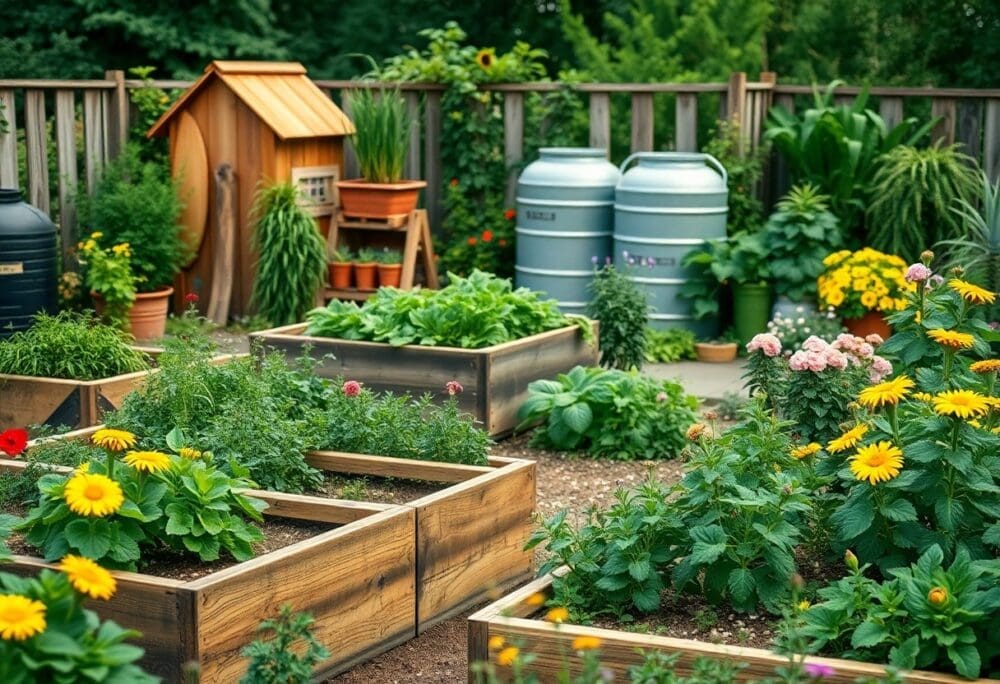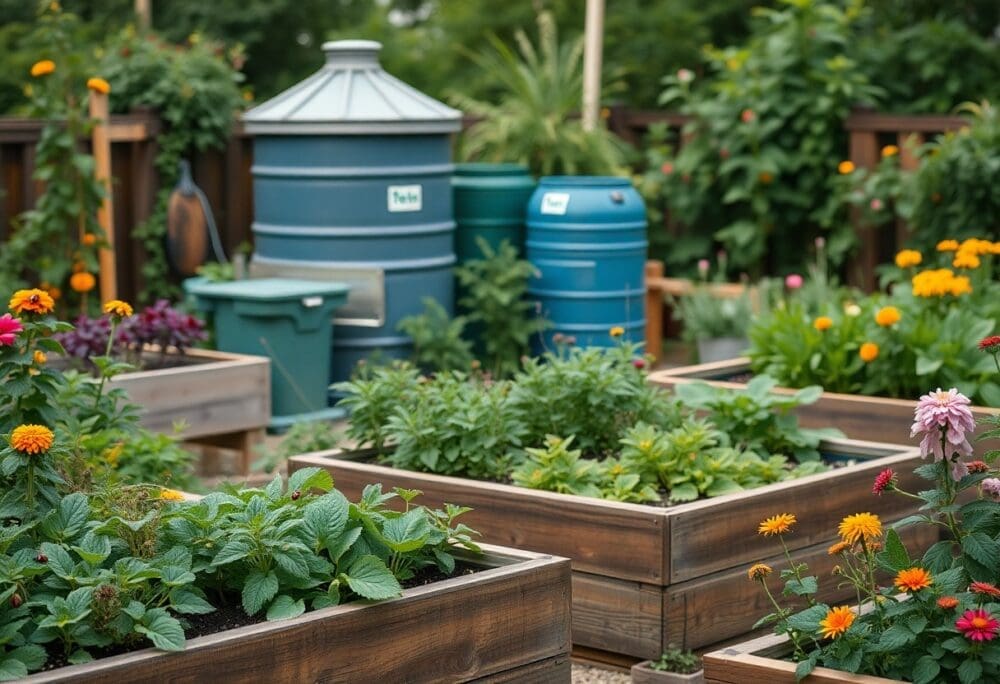Just like any good gardener, you want your garden to flourish while being kind to the planet. Embracing sustainable gardening practices not only nurtures your plants but also promotes a healthier ecosystem. In this list, you’ll discover ten necessary techniques that will help you create a lush, vibrant garden that thrives for years to come. From composting to choosing native plants, these practices will empower you to cultivate a garden that balances beauty with sustainability.
Key Takeaways:
- Implementing composting techniques enriches soil health and reduces waste, providing important nutrients for your plants.
- Choosing native plants not only supports local biodiversity but also requires less water and maintenance, making your garden more sustainable.
- Utilizing organic pest control methods minimizes harm to beneficial insects and promotes a balanced ecosystem in your garden.
Composting Organic Materials
As a garden enthusiast, you can greatly enhance soil quality and reduce waste by composting organic materials. Composting allows you to recycle kitchen scraps and yard waste, creating nutrient-rich soil amendments that nourish your plants. By making this simple practice part of your gardening routine, you foster a sustainable environment while promoting plant health. Not only does composting help you maintain a thriving garden, but it also minimizes your ecological footprint.
Kitchen Scraps
Materials like fruit and vegetable peels, coffee grounds, and eggshells are excellent for composting. By saving these kitchen scraps instead of tossing them in the trash, you can enrich your compost pile with organic matter that adds nutrients to your garden soil. Incorporating these items into your compost not only diverts waste from landfills but also supports the sustainable cycle of your gardening practices.
Yard Waste
One effective way to boost your compost is by including yard waste, such as grass clippings, leaves, and small branches. This organic material is rich in carbon, necessary for balancing your compost and supporting healthy microbial activity. By combining yard waste with kitchen scraps, you create a well-rounded compost that promotes vibrant plant growth and soil health.
It is important to properly manage yard waste to ensure effective composting. Chopping larger pieces into smaller sizes speeds up the breakdown process, allowing for quicker compost creation. Layering your yard waste with brown materials, like dried leaves or straw, helps maintain moisture balance and aeration in the compost pile, providing an ideal environment for decomposition. By incorporating these practices, you can turn yard waste into a valuable resource for your garden.
Native Plant Selection
It is crucial to choose native plants for your garden, as they are adapted to your local climate and soil, creating a resilient ecosystem. Native species often require less water and fewer resources than non-native varieties, resulting in a more sustainable garden. Additionally, these plants support local wildlife, including pollinators, birds, and beneficial insects, ultimately contributing to a thriving garden environment.
Local Species
Any plants that are native to your region are considered local species, and they are invaluable for fostering biodiversity in your garden. By selecting these plants, you ensure that they have co-evolved with the local fauna and flora, making them better suited to survive the local conditions and thrive in your landscape.
Drought-Resistant Varieties
To create a sustainable garden, incorporating drought-resistant varieties can significantly enhance its resilience. These plants are specifically adapted to survive with minimal water, making them ideal for periods of low rainfall or in regions with dry climates.
The benefits of selecting drought-resistant varieties extend beyond water conservation. They typically have deep root systems that improve soil structure and prevent erosion. By utilizing these plants in your garden, you’ll not only reduce your water usage but also support a balanced ecosystem, as they provide food and habitat for local wildlife. Adopting drought-tolerant species allows you to cultivate a stunning garden while promoting sustainability and environmental responsibility.
Rainwater Harvesting
Your garden can benefit significantly from implementing rainwater harvesting. This eco-friendly practice not only helps conserve water but also reduces your water bills. By collecting and utilizing rainwater, you provide your plants with a natural source of moisture, fostering healthier growth while minimizing your environmental footprint. With simple setups, you can create an efficient system that helps you make the most out of nature’s resources.
Rain Barrels
The use of rain barrels is an effective method to collect and store rainwater from your roof. By placing barrels under downspouts, you can gather a substantial amount of water during rainfall events. This stored water can be used later for irrigation, helping you to maintain a sustainable garden even during dry spells. Additionally, rain barrels can be designed to blend seamlessly into your garden aesthetics.
Efficient Irrigation
There’s more to efficient irrigation than just watering your plants; it’s about doing so in a way that maximizes resources. Implementing systems such as drip irrigation or soaker hoses allows water to reach plant roots directly, reducing waste due to evaporation and runoff. By scheduling watering times for early mornings or late afternoons, you can further minimize water loss while ensuring your garden remains lush and vibrant.
A well-planned irrigation system not only conserves water but also promotes healthy plant growth. Consider using timers and moisture sensors to prevent overwatering and ensure plants receive just the right amount of moisture. Incorporating mulching can also help retain soil moisture and keep your garden healthy. As you adopt these practices, your garden will flourish, and you’ll contribute positively to your environment.
Mulching Techniques
Once again, mulching proves to be a game-changer in sustainable gardening. By covering the soil with organic or inorganic materials, you enhance moisture retention, regulate soil temperature, and improve soil health. Different mulching techniques suit various gardening needs, providing benefits that range from reducing erosion to enriching the ecosystem in your garden. Selecting the right type of mulch can significantly influence the health of your plants, ensuring your garden thrives sustainably.
Organic Mulch
Mulching with organic materials such as leaves, straw, or wood chips not only enriches the soil as they decompose but also improves its structure. This type of mulch fosters a healthy ecosystem by attracting beneficial microbes and earthworms, leading to enhanced nutrient availability for your plants. As the organic matter breaks down, it feeds the soil, creating a thriving environment for your garden.
Weed Suppression
With effective mulching, you can significantly reduce the growth of weeds in your garden. By blocking sunlight and preventing weed seeds from germinating, mulch creates a barrier that stifles unwanted growth. This means you spend less time weeding and more time enjoying your thriving garden.
Any gardener knows that weeds compete with your plants for nutrients and water, so controlling their growth is vital. By applying a thick layer of mulch around your plants, you create an effective deterrent against weeds while also retaining soil moisture. This method improves the overall health of your garden, allowing your prized plants to flourish without the stress of competing with invasive plants. Choose the right mulch and you will see a noticeable difference in weed control while promoting a healthier gardening environment.
Crop Rotation
For an effective sustainable gardening practice, crop rotation is necessary. This technique involves changing the planting location of various crops each season, helping to prevent the buildup of soil-borne diseases and pests. By alternating the types of crops you grow, you enhance soil structure and promote biodiversity, leading to healthier plants and ultimately a more productive garden. Implementing a strategic crop rotation plan enables you to optimize yields while maintaining long-term soil health.
Diverse Planting
With diverse planting, you can create a dynamic garden ecosystem that supports a wide range of beneficial organisms. By incorporating various types of plants, such as legumes, leafy greens, and root vegetables, you can enhance pollination, improve soil health, and reduce pest infestations. This diversity not only enriches your garden’s environment but also provides habitat for beneficial insects and microorganisms, leading to resilient and thriving plants.
Soil Nutrient Replenishment
Little do many realize, replenishing soil nutrients is vital for maintaining the health and productivity of your garden. This practice ensures your plants have access to necessary nutrients for growth and development. By rotating crops and introducing nitrogen-fixing plants such as peas or beans, you can naturally enhance soil fertility. Additionally, adding organic matter like compost or mulch can significantly bolster nutrient levels, enhancing overall soil structure and promoting a thriving garden.
Crop rotation not only helps control pests and diseases but also plays a key role in replenishing soil nutrients. By systematically alternating your crops, you can prevent nutrient depletion associated with continuous planting of the same family of plants. Each crop family requires different nutrients, and rotating them ensures a balanced use of your soil’s resources while allowing some plants to restore what others have taken. This practice invites a natural cycle of nutrient replenishment, ultimately resulting in healthier and more productive gardens.
Integrated Pest Management
Unlike conventional practices that rely heavily on chemicals, integrated pest management (IPM) focuses on using a holistic approach to control pests in your garden. By combining various techniques, such as monitoring pest populations and employing cultural, biological, and mechanical controls, you can create a balanced ecosystem. Consider learning more about 10 Tips for Sustainable Gardening to effectively manage pests while minimizing environmental impact.
Natural Predators
One of the most effective methods of pest control is to attract natural predators to your garden. Beneficial insects like ladybugs, lacewings, and predatory wasps can help keep pest populations in check. By planting native flowers and providing habitats, such as insect hotels, you can encourage these allies to thrive and assist you in maintaining a healthy garden ecosystem.
Eco-friendly Treatments
Any sustainable gardener will appreciate the importance of eco-friendly treatments when it comes to pest management. Instead of resorting to harsh chemicals, consider using organic solutions like neem oil, insecticidal soap, or homemade sprays that utilize household ingredients. These treatments are effective in managing pests while ensuring the health of your plants and the surrounding environment.
With eco-friendly treatments, you have a variety of options at your disposal. For instance, garlic spray can deter aphids, while diatomaceous earth acts as a natural barrier against soft-bodied insects. Always test these treatments on a small area first to assess plant tolerance. Not only do these methods align with sustainable practices, but they also help create a safer space for you, your plants, and local wildlife.
Soil Health Improvement
Many gardeners overlook the importance of soil health when it comes to sustainable gardening practices. Enhancing the health of your soil can lead to more vigorous plant growth, improved water retention, and reduced susceptibility to pests and diseases. By adopting methods such as crop rotation, composting, and soil testing, you can create a rich and vibrant environment for your plants to thrive. Investing in soil health not only benefits your garden but also contributes to a healthier ecosystem.
Cover Crops
Soil covers crops are an excellent way to improve the quality of your soil while preventing erosion and nutrient depletion. These crops, such as clover or rye, are grown during off-seasons and can be tilled back into the soil, enriching it with organic matter. When you incorporate cover crops into your gardening routine, you enhance soil structure, enhance moisture retention, and promote beneficial microorganisms that support your plants.
Organic Fertilizers
An effective way to boost your garden’s productivity sustainably is by using organic fertilizers. These fertilizers come from natural sources like compost, manure, and bone meal, providing imperative nutrients without the harsh chemicals found in synthetic options. By choosing organic fertilizers, you can ensure that your plants receive a slow and steady supply of nutrients, improving soil health and fostering a balanced ecosystem in your garden.
Cover crops not only help enrich your soil with organic matter but also enhance nutrient cycling naturally. When you plant greens like vetch or buckwheat, they contribute nitrogen and other nutrients back to the soil, which reduces the need for additional fertilizers. Furthermore, they can smother weeds and keep soil structure intact, making them a versatile addition to your gardening practices. By selecting the right cover crops for your local climate, you can significantly improve the health and fertility of your soil.
Companion Planting
Keep in mind that companion planting is an effective technique for enhancing the health of your garden. By strategically pairing plants that benefit each other, you can create a thriving ecosystem that boosts growth, prevents pests, and optimizes space. This method not only improves your plants’ vitality but also encourages biodiversity in your garden, making it a more resilient environment.
Beneficial Pairings
On your journey to sustainable gardening, consider the power of beneficial pairings. Certain plants can enhance each other’s growth when grown together. For instance, planting basil alongside tomatoes can improve flavor while deterring pests. Similarly, marigolds are excellent companions for a variety of vegetables as they attract beneficial insects while repelling harmful ones.
Pest Deterrence
Planting certain companions can serve as a natural pest deterrent, creating a more harmonious ecosystem in your garden. Crops like garlic and chives are known to repel aphids, while nasturtiums can attract harmful insects away from your veggies. By incorporating these plants into your garden layout, you reduce the need for chemical interventions and promote a healthier growing environment.
This approach utilizes nature’s own defenses, allowing your garden to flourish without synthetic pesticides. By combining pest-repelling plants with your main crops, you create a dynamic relationship that benefits all involved. This leads not only to a reduction in pest populations but also to an overall healthier garden where plants can thrive alongside each other, ensuring your harvest is bountiful and organic.
Sustainable Lawn Care
Not only is sustainable lawn care beneficial for the environment, but it also results in a healthier and more vibrant lawn. By implementing practices that minimize resource consumption and avoid harmful chemicals, you can create a lush green space that thrives naturally. Sustainable lawn care encourages biodiversity, improves soil health, and reduces the need for constant care, allowing you to enjoy your outdoor space with less effort and greater satisfaction.
Mowing Height
One of the simplest yet effective ways to maintain a sustainable lawn is by adjusting your mowing height. Keeping your grass at the appropriate height helps it establish deeper roots, improves water retention, and increases resilience to pests and diseases. Aim to mow your lawn at a height of 3 to 4 inches, allowing your grass to flourish while minimizing evaporation and competing weeds.
No Synthetic Chemicals
Any lawn care routine can benefit significantly from avoiding synthetic chemicals. By using organic methods for weed and pest control, you can maintain a healthier ecosystem while reducing the environmental impact of your gardening practices.
To further expand on the benefits of avoiding synthetic chemicals, consider the long-term effects on your soil and plant health. Natural fertilizers, such as compost and manure, enrich your soil without introducing harmful substances that can leach into groundwater. Additionally, native plants and beneficial insects thrive better in an environment free from synthetic pesticides, leading to a more balanced and vigorous garden. By focusing on natural pest management and organic nutrients, you maximize the health of your lawn while minimizing ecological disruption.
To wrap up
With this in mind, incorporating these 10 sustainable gardening practices will significantly enhance the health and productivity of your garden. By focusing on techniques like composting, native planting, and water conservation, you create an environment that thrives naturally. Embracing these methods not only benefits your plants but also promotes a healthier ecosystem. As you implement these practices, you’ll find that your garden flourishes while minimizing environmental impact, aligning with your goals for a sustainable lifestyle.
Q: What are some effective ways to improve soil health in sustainable gardening?
A: Improving soil health is fundamental for sustainable gardening. One effective method is to incorporate organic matter, such as compost or well-rotted manure, into the soil. This adds nutrients and enhances soil structure, promoting better hydration and aeration. Additionally, practicing crop rotation helps prevent soil depletion and reduces pest infestations by disrupting their life cycles. You can also implement cover cropping, where you plant specific crops to protect and enrich the soil during off-seasons. Native plants and perennials can also help maintain soil integrity while providing habitat for beneficial organisms.
Q: How can I conserve water while maintaining a thriving garden?
A: Water conservation is a key component of sustainable gardening. One effective strategy is to utilize drip irrigation systems, which deliver water directly to the roots of plants, minimizing evaporation and runoff. Additionally, mulching around plants helps retain moisture in the soil by reducing direct exposure to sunlight. Choosing drought-resistant plants or native species that are adapted to local weather conditions can also significantly decrease water usage. Finally, collecting rainwater in barrels provides a sustainable water source for your garden during dry periods.
Q: What role do companion planting and biodiversity play in sustainable gardening?
A: Companion planting and biodiversity are vital aspects of sustainable gardening that enhance plant health and reduce reliance on chemical interventions. Companion planting involves grouping plants together that support each other; for instance, planting marigolds alongside vegetables can deter pests and attract beneficial insects. Increasing biodiversity by incorporating a variety of plants not only creates a more resilient ecosystem but also promotes the presence of pollinators and beneficial organisms that aid in pest control. This holistic approach not only improves plant health but also contributes to the overall environmental balance.






